 Backend Development
Backend Development
 PHP Tutorial
PHP Tutorial
 Detailed explanation of examples of implementing verification code replacement and site-wide search functions in phpcms
Detailed explanation of examples of implementing verification code replacement and site-wide search functions in phpcms
Detailed explanation of examples of implementing verification code replacement and site-wide search functions in phpcms
When using phpcms to replace web pages, in addition to normal replacement columns, content pages, etc., there are other verification codes, form submissions, and search functions. These may have some minor issues with some default files when replacing them. Small changes
The following is the process of success in failure, and finally replaced it with a bug-free replacement. This article mainly introduces the verification code replacement of phpcms and the realization of the whole site search function of phpcms. Friends who need it can refer to it. Next, I hope it can help everyone.
1. Verification code replacement for phpcms
Where there is a verification code, it is usually a form. Then you must first make the form. The form production process is very simple, as follows:
A. Make a form
(1) Log in to your own phpcms background management

(2) After logging in, follow this step to add the form
a. Module------Form Wizard: As shown in the figure
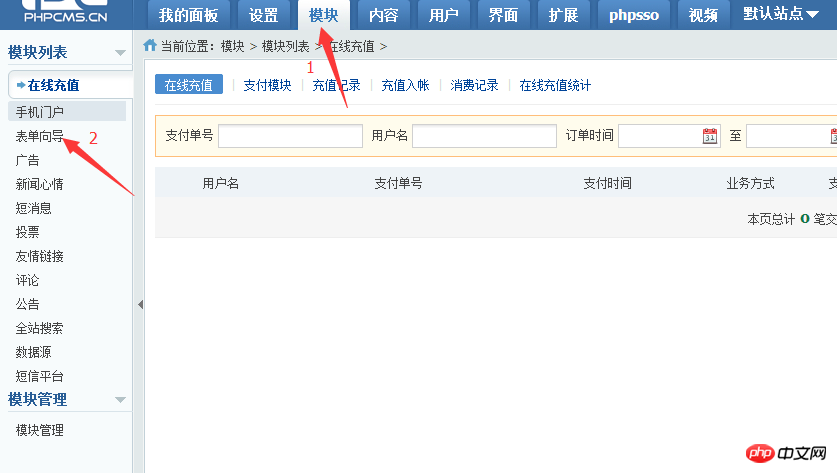
b. After opening the form wizard, click the "Add Form Wizard" button, such as Figure:

c. Open the dialog box to add information, click OK
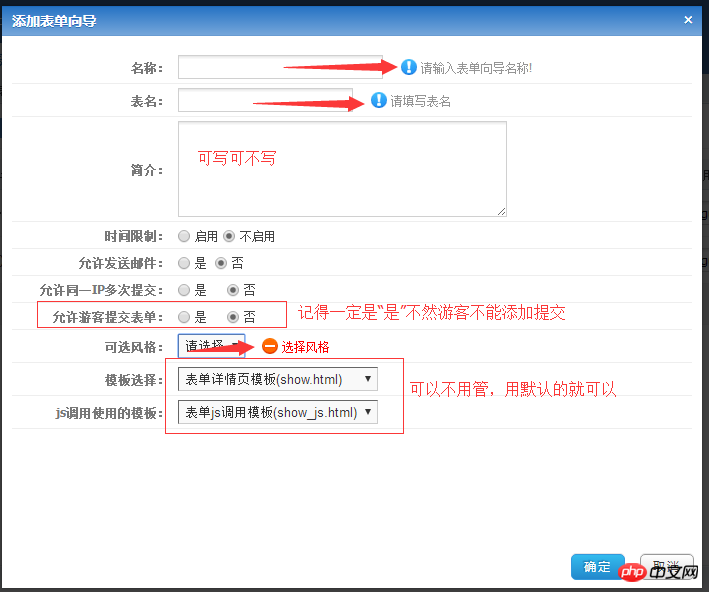
d. After confirmation, the The form you just added appears in this window, as shown in the figure:

(3) Add fields to the form
a. Click on the current page "Add Field" button to open the Add Field window




 ## d. Now that the form is there, add the form To the replacement web page, just copy this js sentence, as shown in the picture:
## d. Now that the form is there, add the form To the replacement web page, just copy this js sentence, as shown in the picture:
Copy this sentence to the corresponding position in the web page
 The form is now here, you can see the style of the form and click the "Preview" button
The form is now here, you can see the style of the form and click the "Preview" button
(3) Modify the beginning information of the form
Add to the web page normally After that, such a style will appear, as shown in the picture:
 a. Open the default template folder of your phpcms template, as shown in the picture
a. Open the default template folder of your phpcms template, as shown in the picture
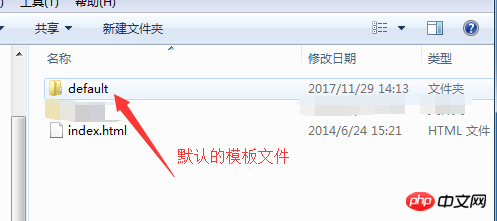 b. Open the default folder, find the "show_js.html" file in the "formguide" folder, and open the file, as shown in the figure:
b. Open the default folder, find the "show_js.html" file in the "formguide" folder, and open the file, as shown in the figure:
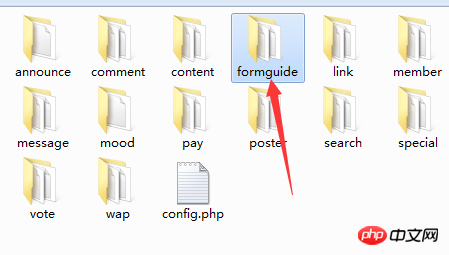
 c. In the open show_js.html file, modify this position, as shown in the figure:
c. In the open show_js.html file, modify this position, as shown in the figure:
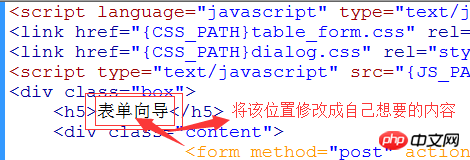 In this case, the form is truly over
In this case, the form is truly over
B. Add verification code to the form
(1) Add a field name "Verification Code", this step is all above, unknown
(2) Similarly in the default folder, find " "show_js.html" file in the "formguide" folder, open the file
Add such a piece of code at this location, as shown in the picture:
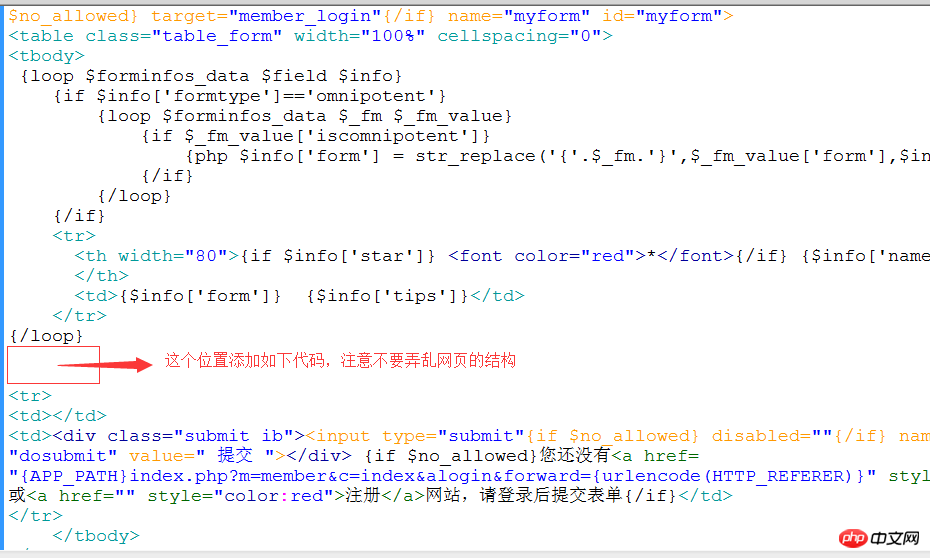 Added The code is as follows:
Added The code is as follows:
(3) After the files in the default template have been modified, there is one more place that needs to be modified, which is to change the index.php file under \modules\formguide, as shown in the figure
If you want to find this folder, it also exists in the phpcms folder
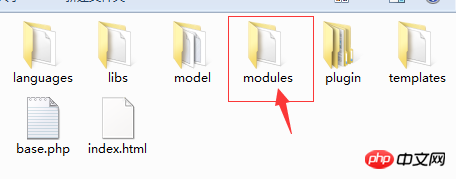

Open the file and add this code. The location of the addition is as shown in the figure:

The added code is as follows:
In this way, the verification code is completed, as shown in the picture:

You can also modify the content of the verification code by clicking on the picture.
Through continuous attempts, this is the complete step to replace the verification code~~~~
If you want to view the form submitted by the user, you can check this place:
On the right side of each form, click "Information List":

#Enter the information list to see who has added the form and what content they submitted, as shown in the figure:


2. phpcms realizes the whole-site search function
The so-called whole-site search function is actually based on the input Search the site for content.
Step one: Submit and write the form on the search page. I won’t go into details about how to write the form.
In this way, the content you want to find is passed into the index.php file for processing (the index.php file is in modules/search/index.php). This php file is to judge the various values passed in above. And processing
As shown in the figure:

Second step: The page returned by this form form
The page that returns the value is not The column page is neither a list page nor a content page, it is an independent file
(1) Create a search folder under your own template: the path is as follows:

It is not created in the content file, but the search folder is created outside it
(2) There are several files in the search folder (remove it on your own return page) Divide)
Split a whole static page into several parts like other pages: header, footer, index, list, etc. 4 page files
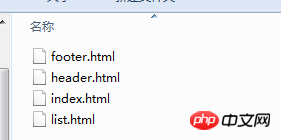
(3) Display of search results
I won’t go into details about splitting. Anyone who knows phpcms will split it. Now it is to modify the index page and list page
index page It is to search for the page returned when there is no content. This page can be set by yourself, or you can use the default page of phpcms. The
list page is the search result page. Please remind: In addition to displaying the search content, other content should not be traversed and displayed on this page, because this will cause the search results to be wrong. Search results will be displayed.
The traversal code for displaying the search results page is as follows: (Put this where you want it to be displayed, and modify the style according to your own style)
Note: You can go into the default template of phpcms to view it How to write the files in the search folder? Note that there are several js files that need to be imported and must be written.
Step 3: Check
Check whether there is any problem with the result page:
(1) Search for products with "Qi" in the site

(2) Check whether the page is out (there should be pagination if there are many things, and the search keywords are highlighted. This is a modification of the style)

The replacement of phpcms's whole site search ends here.
Points to note:
(1) The search folder is a file at the same level as the template content
(2) The files in the search folder also need to be split into "Head, middle, bottom"
(3) Except for the search results, other contents of all the split files cannot have any traversal of the search database
Related recommendations:
Why is phpcms site-wide search not as effective as many people boast?
Brothers PHPCMS basic video tutorial resource sharing
How to build a beautiful PHP verification code class file and how to call it
The above is the detailed content of Detailed explanation of examples of implementing verification code replacement and site-wide search functions in phpcms. For more information, please follow other related articles on the PHP Chinese website!

Hot AI Tools

Undresser.AI Undress
AI-powered app for creating realistic nude photos

AI Clothes Remover
Online AI tool for removing clothes from photos.

Undress AI Tool
Undress images for free

Clothoff.io
AI clothes remover

Video Face Swap
Swap faces in any video effortlessly with our completely free AI face swap tool!

Hot Article

Hot Tools

Notepad++7.3.1
Easy-to-use and free code editor

SublimeText3 Chinese version
Chinese version, very easy to use

Zend Studio 13.0.1
Powerful PHP integrated development environment

Dreamweaver CS6
Visual web development tools

SublimeText3 Mac version
God-level code editing software (SublimeText3)

Hot Topics
 PHP 8.4 Installation and Upgrade guide for Ubuntu and Debian
Dec 24, 2024 pm 04:42 PM
PHP 8.4 Installation and Upgrade guide for Ubuntu and Debian
Dec 24, 2024 pm 04:42 PM
PHP 8.4 brings several new features, security improvements, and performance improvements with healthy amounts of feature deprecations and removals. This guide explains how to install PHP 8.4 or upgrade to PHP 8.4 on Ubuntu, Debian, or their derivati
 7 PHP Functions I Regret I Didn't Know Before
Nov 13, 2024 am 09:42 AM
7 PHP Functions I Regret I Didn't Know Before
Nov 13, 2024 am 09:42 AM
If you are an experienced PHP developer, you might have the feeling that you’ve been there and done that already.You have developed a significant number of applications, debugged millions of lines of code, and tweaked a bunch of scripts to achieve op
 How To Set Up Visual Studio Code (VS Code) for PHP Development
Dec 20, 2024 am 11:31 AM
How To Set Up Visual Studio Code (VS Code) for PHP Development
Dec 20, 2024 am 11:31 AM
Visual Studio Code, also known as VS Code, is a free source code editor — or integrated development environment (IDE) — available for all major operating systems. With a large collection of extensions for many programming languages, VS Code can be c
 Explain JSON Web Tokens (JWT) and their use case in PHP APIs.
Apr 05, 2025 am 12:04 AM
Explain JSON Web Tokens (JWT) and their use case in PHP APIs.
Apr 05, 2025 am 12:04 AM
JWT is an open standard based on JSON, used to securely transmit information between parties, mainly for identity authentication and information exchange. 1. JWT consists of three parts: Header, Payload and Signature. 2. The working principle of JWT includes three steps: generating JWT, verifying JWT and parsing Payload. 3. When using JWT for authentication in PHP, JWT can be generated and verified, and user role and permission information can be included in advanced usage. 4. Common errors include signature verification failure, token expiration, and payload oversized. Debugging skills include using debugging tools and logging. 5. Performance optimization and best practices include using appropriate signature algorithms, setting validity periods reasonably,
 PHP Program to Count Vowels in a String
Feb 07, 2025 pm 12:12 PM
PHP Program to Count Vowels in a String
Feb 07, 2025 pm 12:12 PM
A string is a sequence of characters, including letters, numbers, and symbols. This tutorial will learn how to calculate the number of vowels in a given string in PHP using different methods. The vowels in English are a, e, i, o, u, and they can be uppercase or lowercase. What is a vowel? Vowels are alphabetic characters that represent a specific pronunciation. There are five vowels in English, including uppercase and lowercase: a, e, i, o, u Example 1 Input: String = "Tutorialspoint" Output: 6 explain The vowels in the string "Tutorialspoint" are u, o, i, a, o, i. There are 6 yuan in total
 How do you parse and process HTML/XML in PHP?
Feb 07, 2025 am 11:57 AM
How do you parse and process HTML/XML in PHP?
Feb 07, 2025 am 11:57 AM
This tutorial demonstrates how to efficiently process XML documents using PHP. XML (eXtensible Markup Language) is a versatile text-based markup language designed for both human readability and machine parsing. It's commonly used for data storage an
 Explain late static binding in PHP (static::).
Apr 03, 2025 am 12:04 AM
Explain late static binding in PHP (static::).
Apr 03, 2025 am 12:04 AM
Static binding (static::) implements late static binding (LSB) in PHP, allowing calling classes to be referenced in static contexts rather than defining classes. 1) The parsing process is performed at runtime, 2) Look up the call class in the inheritance relationship, 3) It may bring performance overhead.
 What are PHP magic methods (__construct, __destruct, __call, __get, __set, etc.) and provide use cases?
Apr 03, 2025 am 12:03 AM
What are PHP magic methods (__construct, __destruct, __call, __get, __set, etc.) and provide use cases?
Apr 03, 2025 am 12:03 AM
What are the magic methods of PHP? PHP's magic methods include: 1.\_\_construct, used to initialize objects; 2.\_\_destruct, used to clean up resources; 3.\_\_call, handle non-existent method calls; 4.\_\_get, implement dynamic attribute access; 5.\_\_set, implement dynamic attribute settings. These methods are automatically called in certain situations, improving code flexibility and efficiency.





